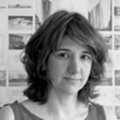MIES VAN DER ROHE AND THE BAUHAUS.
Mies van der Rohe directed the Bauhaus between September 1930 and August 1933. The last stage of the school for the architect meant his first academic experience: an activity that he would continue in Chicago and in parallel with professional practice until the end of the 1950s.
The documentary Bauhaus. El mito de la modernidad , directed by Kertin Stutterheim and Niels Bolbrinker, starts by showing some period photographs of the school in Dessau: expert hands protected by gloves free them from the protective wrapping. They are exhibited in front of the camera as if they were a museum piece. The image of the Bauhaus has become indissolubly linked to this building. Walter Gropius, its founder, wrote in 1919 the design schedule that began with the statement The ultimate goal of all visual artistic activity is construction! It is therefore surprising that the school did not have an active architecture department until 1927, with Hannes Meyer, who would become the institution's second director, as its first head. Jorge Torres Cueco provides a revealing chronological table of the periods teachers were linked to the school in the booklet included in Arquia's CD edition of the documentary. The graph shows the staff that accompanied Mies in the last stage of the Bauhaus: alongside veteran architects Joseph Albers and Wassily Kandinski, there was the photographer Walter Peterhans and the architects Alfred Arndt, Ludwig Hilberseimer and Lilly Reich, an interior designer, as the latest addition. Mies' pedagogical activity meant a change from the guidelines of his predecessor, and as director of the school he faced various difficulties, among which was the revolt of the students who considered him an elitist architect.
Mies developed a type of academic exercise that consisted in designing small houses under strict starting premises and very much related to the professional work of his office. It was aimed at training the visual perception of living areas from the consideration of the precise physical constitution of the elements that make it up. Between 1926 and 1937, Mies and Lilly Reich designed eighty exhibition spaces for the German industry and government - including the Weissenhof housing estate and the Barcelona Pavilion - which constitute an extraordinary capital of experience in relation to what is organised for viewing. Laura Lizondo Sevilla's doctoral thesis 'Arquitectura o exposición. Fundamentos de la arquitectura de Mies van der Rohe' includes a magnificent body whose implications for Miesian production must be further evaluated. Mies' aesthetic considerations contemplated a new visual order in relation to architecture and the modern world, and did so in a different way from his contemporaries. This becomes evident by comparing, for example, the different demands made on photography, the primary instrument of visual production, by Mies or László Moholy-Nagy, who led the field of visual culture at the Bauhaus with his wife Lucía until 1928.
László Moholy-Nagy was looking for new visions and a different interpretation of the world. On the one hand, he experimented with mechanical reproduction devices: frames, simultaneous projections, X-rays, microscopic photography, light effects and kinetic effects or optical distortions. On the other hand, he looked for unusual points of view, oblique directions, strange proportions, field of view curvature, overlaps, repetitions, etc. A whole new approach that is in keeping with the avant-garde movements of the early 20th century.
Juan Antonio Cortés, in his book'La liberación vanguardista'. 'Nuevos principios formales en el arte y en la arquitectura del Siglo XX. 1901-1931'(New formal principles in 20th century art and architecture. 1901-1931), is a phenomenal two-volume compendium of new plastic proposals that question the laws of perspective conventions and propose unpublished formal procedures. Significantly, the first chapter is entitled 'A space without perspective. Flatness and deformation'. The following chapters are entitled and organized according to the principles shared by these new trends: a fragmented gaze, the presence of time, the abandonment of the centre, diagonal visions, the triumph over gravity, the breaking of the box, the dissolution of the bodies.
Mies was also deeply influenced by avant-garde sensibility and made intensive use of photography, without being interested in shooting the camera himself or investigating photographic technique. It helped to achieve new space apprehensions without giving up perspective, but quite the opposite was true. Mies commissioned very large photographic image expansions of the sites to draw and project on them -in all contests-, he had the models photographed, elaborated suggestive photo-assemblies of his proposal's interiors -collages-, used photo-murals to change the perception of space looking for immersive experiences -exposures- to the point of making patent for photographic wallpaper - check out again Laura Lizondo's thesis-, is also known for the strict demands he maintained with his work's reports.
Once the Bauhaus had been closed in Berlin and Mies settled in Chicago, he took with him Peterhans and Hilberseimer: the former in charge of visual training, the latter of urban planning at the Armour Institute, then IIT. When he superimposes coloured paper silhouettes on the interior image of the immense Glenn L. Martin Company factory, projected by Albert Kahn, to outline the limits of a concert hall (Concert Hall) (1942), he gives a new show of the awareness of the gaze's intermediary role in the new aesthetic appreciation, in this case, of an industrial space and of the photographic representation's potential as a method of spatial exploration. The thesis of Luis Pancorbo Crespo: Industrial architecture by Albert Kahn Inc. 1900-42. Architecture as a technical object informs the body of work of this architectural engineer, and provides with reflections on the relationships between art form (kunstform) and construction art (baukunst) that concern Mies' work and that of his followers such as Gordon Bunshaft. Two other doctoral theses provide content to feed this dichotomy: Mies' Two-way Span by Eduardo Genari Mantovani and Forma y tectonicidad: estructura y prefabricación by Gordon Bunshaft's work of Nicolás Sica Palermo.
Mies established a new orientation in visual education. Progress in learning to see is primarily about differentiating perceptions. Weightlessness, floating, unstable or asymmetrical balance, directional equivalence, movement, openness aspirations are also manifested in Mies' projects, who showed an intense awareness of the way of being and the way of appearing in the world. Mies scrutinizes his surroundings to try to arrange them differently, to provide the materials with a new organisation that fulfils our aesthetic aspirations. Mies doesn't push the camera, but changes the world so that it shows itself in a different way.






